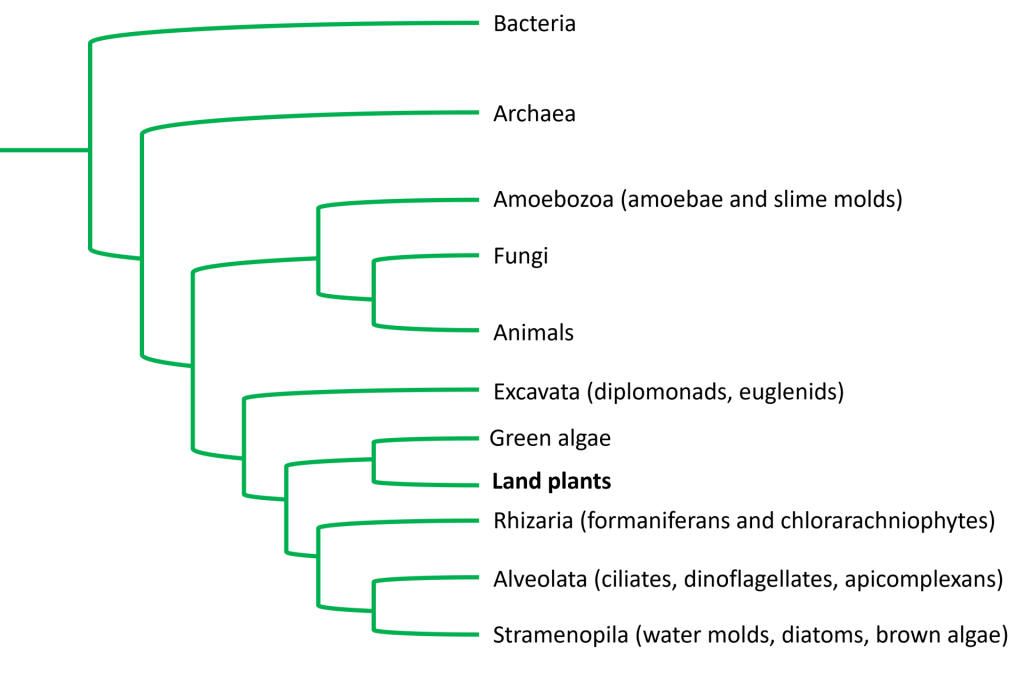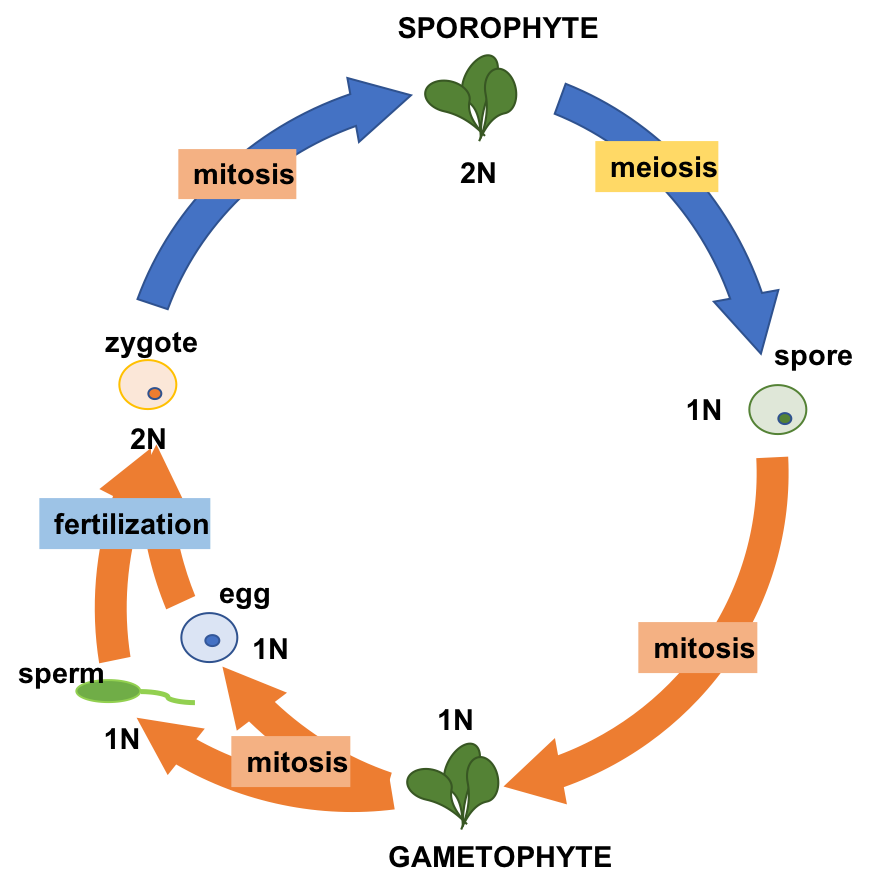5.1 Plant Adaptations to Life on Land
Classification of Land Plants on the Phylogenetic Tree of Life
Plants are a group of eukaryotic photoautotrophs that evolved to live on land. As eukaryotes, their cells contain a nucleus, mitochondria, and a complex system of internal membranes including the endoplasmic reticulum and Golgi apparatus. As photosynthetic eukaryotes, their cells also contain chloroplasts.
Plants are a monophyletic group (or clade), meaning they include a common ancestor and all of its descendants. In other words, all plants share a single evolutionary origin. Land plants evolved from a photosynthetic ancestor shared with green algae, a group of protists.

Life in Water Compared to Land
The ancestor of all plants was an aquatic, green algal-like species with a cell wall composed of cellulose. Living in the water provides a number of advantages compared to life on land:
- In water or near it, plants can absorb water from their surroundings with no need for any special organ for absorbing the water, and no need for any special tissue to prevent desiccation (drying out).
- Water provides a sort of external support structure and buoyancy to living things; in contrast, living on land requires additional structural support to avoid falling over.
- Sperm and egg can easily swim to each other in a water environment, and do not need protection from desiccation. Sperm and egg require alternative strategies for getting to each other and avoiding drying out when on land.
- Water filters out a significant amount of ultraviolet (UV) light, which is highly destructive to DNA (and one of the reasons to wear sunblock). No such filtering occurs in air, so terrestrial organisms require alternative strategies for protection against UV radiation.
If life on land presents so many challenges, why did any plants evolve to live on land? Life on land offers several advantages:
- Sunlight is abundant in the air compared to water. Water acts as a filter, altering the spectral quality of light absorbed by the photosynthetic pigment chlorophyll.
- Carbon dioxide, the required carbon source for green plants, is more readily available in air than in water, since it diffuses faster in air.
- Land plants evolved before land animals; therefore, no predators threatened early plant life. This situation changed over time as animals colonized land, where they fed on the abundant sources of nutrients in the established flora. As a result of this selective pressure by plant-eating animals, plants evolved adaptations to deter predation, such as spines, thorns, and toxic chemicals.
Terrestrial Adaptations
The evolution of specific adaptations in aquatic algae allowed them to transition to a terrestrial environment.
The 5 major terrestrial adaptations which are present in many land plants include:
- Waxy cuticle: Covers the outer surface of the plant and prevents drying out through evaporation. It also provides partial protection against radiation damage from UV light. A waxy cuticle is universally present in all land plants, though it is much thinner in nonvascular plants called bryophytes compared to all other land plants.
- Stomata (singular: stoma): Are pores or holes that allow for the exchange of gases (such as oxygen and carbon dioxide) between plant cells and the environment. They are necessary in land plants because the waxy cuticle blocks the free flow of gases. Stomata are present in all land plant lineages except liverworts, which are closely related to mosses.
- Roots or Root-Like Structures: These anchor plants to the soil. True roots grow deeper into the soil and also help with water absorption.
- Gametangia: These are specialized structures that protect gametes from drying out. Archegonia produce eggs, whereas antheridia produce sperm. After fertilization, the zygote remains in the archegonium, where it is protected and nourished to develop into an embryo.
- Alternation of generations is a type of life cycle found in all plants in which the organism alternates between two multicellular stages:
-
- Gametophyte: A haploid (n) stage that produces gametes (sperm and egg) through mitosis.
- Sporophyte: A diploid (2n) stage that produces haploid spores through meiosis.

Figure 5.1.2 Image Description
The diagram illustrates the alternation of generations in plants, showing the life cycle stages that alternate between haploid (1N) and diploid (2N) phases.
- At the top, a diploid plant (sporophyte, 2N) undergoes meiosis, producing haploid spores (1N).
- The spore grows into a haploid gametophyte (1N) through mitosis.
- The gametophyte produces haploid gametes: sperm (1N) and egg (1N).
- During fertilization, sperm and egg unite to form a diploid zygote (2N).
- The zygote undergoes mitosis, growing into a new diploid sporophyte (2N), completing the cycle.
Blue arrows mark the sporophyte (diploid) phase, while orange arrows mark the gametophyte (haploid) phase. The cycle highlights the alternation between sexual and asexual reproductive stages.
Alternation of generations is not a unique adaptation to life on land (it also occurs in some aquatic green algae), but modifications to this life cycle in land plants do function as adaptations.
Knowledge Check
Text Description
- Gametangia
- Waxy cuticle
- Stomata
- Roots
- Stomata
- Alternation of generations
- Roots or root-like structures
- Chloroplasts
- They anchor the plant to soil
- They facilitate gas exchange
- They protect gametes from drying out
- They produce energy from sunlight
- Land offered greater structural support
- Carbon dioxide and sunlight were more abundant
- Sperm could swim more easily on land
- DNA was less exposed to UV radiation
- Alternating between aquatic and terrestrial habitats
- Alternating between gametophyte and sporophyte stages
- Alternating between photosynthesis and respiration
- Alternating between root and shoot growth phases
Answers:
- b. Waxy cuticle
- d. Chloroplasts
- c. They protect gametes from drying out
- b. Carbon dioxide and sunlight were more abundant
- b. Alternating between gametophyte and sporophyte stages
OpenAI. (2025). ChatGPT. [Large language model]. https://chat.openai.com/chat
Prompt: Create 5 multiple-choice questions using the following content
“Organismal Biology” by Georgia Tech Biological Sciences is licensed under a CC BY-NC-SA, except where otherwise noted. Modifications: Edited and reworded

